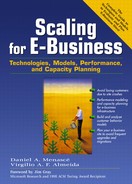11.3. Characterizing Customer Behavior
Chapter 2 introduced Customer Behavior Model Graphs (CBMGs) and the Customer Visit Model (CVMs) as examples of models that characterize customer behavior. That chapter described how the static portion of the CBMG can be built. We describe in this section how the dynamic portion of the CBMG is obtained from HTTP logs. A good part of this description is adapted from a paper by Menascé et al [19].[1]
[1] ©1999 ACM.
We start by reviewing and extending the definition of the CBMG presented in Chapter 2. The CBMG can be used to capture the navigational pattern of a customer through an e-commerce site. This pattern includes two aspects: a transitional and a temporal one. The former determines how a customer moves from one state (i.e., an e-business function) to the next. This is represented by the matrix of transition probabilities. The temporal aspect has to do with the time it takes for a customer to move from one state to the next. This time is measured from the server's perspective and is called server-perceived think time or just think time. This is defined as the average time elapsed since the server completes a request for a customer until it receives the next request from the same customer during the same session. Figure 11.3 illustrates this definition. As it can be seen, the server-side think time is given by t3 – t2 and is equal to 2 × nt + Zb, where nt represents the network time and Zb is the browser-side think time. A think time can be associated with each transition in the CBMG.
Figure 11.3. Browser-Side and Server-Side Think Times. Reprinted from [19] © 1999 ACM.

So, a CBMG can be defined by a pair (P, Z) where P = [pi,j] is an n × n matrix of transition probabilities between the n states of the CBMG and Z = [zi,j] is an n × n matrix that represents the average think times between the states of the CBMG. Recall that state 1 is the Entry state and n is the Exit state. In Chapter 2, we discussed metrics derived from the CBMG. We revisit these here in a more formal way.
Example 11.3
Consider the CBMG of Fig. 11.4. This CBMG has seven states; the Exit state, state seven, is not explicitly represented in the figure. Let Vj be the average number of times that state j of the CBMG is visited for each visit to the e-commerce site, i.e., for each visit to the state Entry. Consider the Add to Cart state. We can see that the average number of visits (VAdd) to this state is equal to the average number of visits to the state Select (VSelect) multiplied by the probability (0.2) that a customer will go from Select to Add Cart. We can then write the relationship
Figure 11.4. CBMG for Ex. 11.3

Equation 11.3.5

Consider now the Browse state. The average number of visits (VBrowse) to this state is equal to the average number of visits to state Search (VSearch) multiplied by the probability (0.2) that a customer will go from Search to Browse, plus the average number of visits to state Select (VSelect) multiplied by the probability (0.30) that a customer will go from Select to Browse, plus the average number of visits to the state Add to Cart (VAdd) multiplied by the probability (0.25) that a customer will go from Add to Cart to Browse, plus the average number of visits to the state Browse (VBrowse) multiplied by the probability (0.30) that a Customer will remain in the Browse state, plus the number of visits to the Entry state multiplied by the probability (0.5) of going from the Entry state to the Browse state. Hence,
Equation 11.3.6

So, in general, the average number of visits to a state j of the CBMG is equal to the sum of the number of visits to all states of the CBMG multiplied by the transition probability from each of the other states to state j. Thus, for any state j (j = 2,…, n – 1) of the CBMG, one can write the equation
Equation 11.3.7

where pk,j is the probability that a customer makes a transition from state k to state j. Note that the summation in Eq. (11.3.7) does not include state n (the Exit state) since there are no possible transitions from this state to any other state. Since V1 = 1 (because state 1 is the Entry state), we can find the average number of visits Vj by solving the system of linear equations
Equation 11.3.8
![]()
Equation 11.3.9

Note that Vn = 1 since, by definition, the Exit state is only visited once per session. This system of linear equations can be solved using the MS Excel workbook cbmg.xls found on this book's website or by using any other package (e.g., SAS, Mathematica, Matlab).
As mentioned in Chapter 2, we can obtain useful metrics from the CBMG. Once we have the average number of visits (Vj) to each state of the CBMG, we can obtain the average session length as
Equation 11.3.10

For the visit ratios of Ex. 11.3, the average session length is
Equation 11.3.11

The buy to visit Ratio is simply given by VPay
